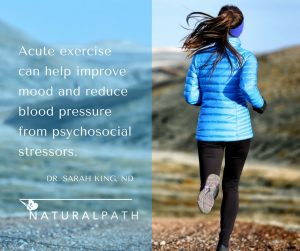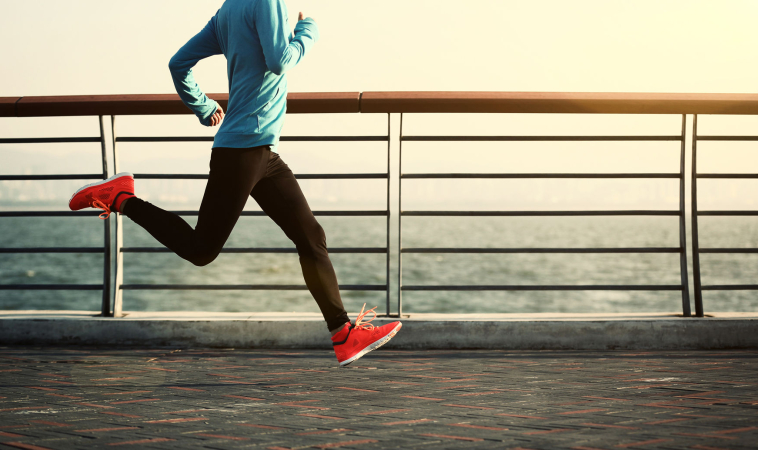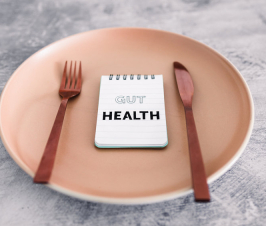Seasonal Weather Changes
Dr. Sarah King, ND
 The changing of weather and seasons can be tough on many of us. Depending on where you live, you might be experiencing frigid cold temperatures, snow fall and freezing rain, or for our friends in the south, the temperature shifts might only include transitioning to longer-sleeved shirts and light sweaters. But regardless of this temperature shift, if you’re in the Northern hemisphere, you get to experience the shortening of days as we lose daylight hours over the winter months.
The changing of weather and seasons can be tough on many of us. Depending on where you live, you might be experiencing frigid cold temperatures, snow fall and freezing rain, or for our friends in the south, the temperature shifts might only include transitioning to longer-sleeved shirts and light sweaters. But regardless of this temperature shift, if you’re in the Northern hemisphere, you get to experience the shortening of days as we lose daylight hours over the winter months.
So how does this impact our health and lifestyle? For many of us, it means the increased risk of low vitamin D levels, but losing our daylight also has implications on our mental health and our daily routine.
I commonly hear from patients that they want to stay active during this time, but it’s much more difficult to get out. Either it’s dark out by the time the workday is done, or the colder temperatures are a huge deterrent.
Outdoor Exercise
Walking, hiking, running, training, cycling. Colder temperatures shouldn’t stop you from getting outside, but we do have to adapt to these changes and be prepared for whatever the elements throw our way. Preparation is key and dressing weather-appropriate will make a huge difference in your ability to stay outdoors.
1) Check the weather forecast
Okay, so our weather forecasts aren’t 100% accurate, but it’s the best we have prediction-wise. Mother nature is composed of so many different forces and variables that there’s no way to call every move. But for the most part, we can predict rain and snow trends, and the temperature outside. Before you head out of the house, step outside your door. Get a feel for the air. Is it windy out? Is the ground wet? Any chance it’s going to pour down on you? Weather forecasts can help you to prepare and dress appropriately for whatever mother nature sends our way.
2) Dress appropriately
Having the right outerwear can make a huge difference if you’re out in the cold. Layer appropriately and opt for sweat-wicking fabrics to keep you dry and warm(er). Merino wool is a fantastic fabric for wicking away sweat and wet. Merino wool socks are a great idea for hiking, winter or snow running, skiing, or anytime when the ground is soaked. Even if your shoes are waterproof or made with Gortex, your feet still sweat (or they should), so keep them dry with a nice pair of wool socks.
Running and cycling wear are usually made with lighter fabrics, as your temperature will warm as you start your workout. In my experience, the first 1-2 kilometers are often the coldest, but afterward, the body warms up and you can become overheated more easily. Play around with how many layers you need to stay warm at different temperatures. For example, can you get away with shorts in 10°C/50°F weather? Maybe you notice that at 5°C/40°F you need a hat and long sleeves, but no jacket. Regardless, there is enough active apparel for the outdoors available, from running gloves to hats, leg warmers, and down vests/jackets, slim-fitting raincoats and face guards.
For those in climates with snow and slippery surfaces, it’s worth grabbing a pair of traction aids. Traction aids are made with a rubber webbing that stretches and fits over your shoes. Additionally, they feature replaceable spikes to help increase stability, and prevent slips and falls on slippery surfaces. Because of their flexible and compact design, they can easily be rolled up and shoved in a pocket or bag when not in use.
3) Plan for the dark
We’re short of daylight hours which truncates the time available to be visible outdoors. If you plan on going out as the sun is rising, setting, or after it has disappeared, make sure to wear plenty of reflective gear. Make yourself visible and avoid wearing dark colors. Bring a mini flashlight with you or have a travel light attached to you so that cars, bikes and other pedestrians can see you. For extra safety, have a buddy with you. If you don’t have a buddy, invest in a Road ID bracelet to have all of your emergency information on you. Road ID also makes a selection of gear with reflectors and lights to increase your visibility to others.
4) Timing and motivation
During this time of year, it can be challenging to have the motivation to get out. Or perhaps it’s an issue with discipline – or both. We miss the gorgeous days of summer, with later sunsets and earlier sunrises. Looking outside now, many of us would rather be curled up indoors. Not to mention, with the holidays approaching, we all seem to be overwhelmed with tasks, shopping, events, planning, and traveling. How can we even fit proper physical activity in?
It’s also a time a year when stress levels rise. Where we could really benefit from extra self-care but we are often left taking care of other things or other people. Getting outside and moving can be a great way to release tension and take a break from the holiday rush, as well as people in our lives who may bring extra stress with them. Acute exercise can help improve mood1, 2, and reduce blood pressure from psychosocial stressors3.
Getting outdoors in nature presents its own unique benefits. Although exercise in general, (even gentle exercise, or that consisting of about 30 minutes) can improve stress and mood, being outdoors around nature can be even more beneficial. The positive effects of forest-bathing have been shown in studies, but even just having a view of nature can have restorative effects on stress4. Positive effects of viewing nature include an increased sense of well-being, decreased physiological stress responses, and an induction of positive emotional states4. Access to forest trails and state/provincial or national parks is one way to improve stress, and perhaps increase motivation to be active outdoors. For those not in close proximity to these types of areas, even a walk through a city or town park may be helpful, being around trees and small green spaces.
As our days are shorter (and darker), taking advantage of the outdoors can be a positive motivator. It comes down to that feeling we get during and post-exercise, and remembering that feeling. For some, it might be a “runner’s high” and for others, just the effect of being outdoors in the fresh air or surrounded by nature. The winter season shouldn’t be a deterrent from getting outdoors, but instead should inspire new activity. Whether you like to cross-country or downhill ski, cycle, skate, hike, or any other outdoor winter activity, there are many options for those of all athletic abilities. Be safe and plan accordingly. Dress for the weather and make yourself visible if you’re out while the sun is down. And lastly, remember how great it’ll feel getting out there: It might be your stress relief from the holiday season, an escape from a hectic schedule, or it could be a family or group activity. Enjoy this time with others, bring them with you and help motivate each other.
 Dr. Sarah King is a licensed Naturopathic Doctor, graduating from the Canadian College of Naturopathic Medicine in 2014. Prior to completing her medical studies, she attended Nipissing University where she received her Honors Bachelor of Science in Biology. Sarah has a passion for women’s health and is a birth doula in Durham and Toronto Region. She treats a wide variety of health conditions including menstrual disorders and hormone balancing, fertility, prenatal care, digestive concerns, skincare and mental health/anxiety. Outside the office Sarah is an avid runner with a love of the GTA’s best forest trails. She also continues to improve her yoga practice and teaches breath work as part of stress management counseling to her patients.
Dr. Sarah King is a licensed Naturopathic Doctor, graduating from the Canadian College of Naturopathic Medicine in 2014. Prior to completing her medical studies, she attended Nipissing University where she received her Honors Bachelor of Science in Biology. Sarah has a passion for women’s health and is a birth doula in Durham and Toronto Region. She treats a wide variety of health conditions including menstrual disorders and hormone balancing, fertility, prenatal care, digestive concerns, skincare and mental health/anxiety. Outside the office Sarah is an avid runner with a love of the GTA’s best forest trails. She also continues to improve her yoga practice and teaches breath work as part of stress management counseling to her patients.
References
1. Cairney, J., Kwan, M.Y., Veldhuizen, S., and Faulkner, G.E. “Who uses exercise as a copy strategy for stress? Results from a national survey of Canadians” (2014) J Phys Act Health. 11(5): 908-16
2. Mata, J., Hogan, C.L., Joormann, J., et al. “Acute exercise attenuates negative affect following repeated sad mood inductions in persons who have recovered from depression” (2013) J Abnorm Psychol. 122(1): 45-50
3. Hamer, M., Taylor, A., and Steptoe, A. “The effect of acute aerobic exercise on stress related blood pressure responses: A systematic review and meta-analysis” (2006) Biol Psych. 71(2): 183-190
4. Alvarsson, J.J., Wiens, S., and Nilsson, M.E. “Stress recovery during exposure to nature sound and environmental noise” (2010) Int J Environ Res Public Health. 7: 1036

















